Render Parameters
Commands and settings for rendering an image are contained within the Render Scene dialog box. This dialog box includes several tabbed panels.
After you're comfortable with the scene file and you're ready to render a file, you need to open the Render Scene dialog box, shown in Figure 43.2, by means of the Rendering ![]() Render menu command (F10) or by clicking the Render Scene button on the main toolbar. This dialog box has several panels: Common, Renderer, Render Elements, Raytracer, and Advanced Lighting. The Common panel includes commands that are common for all renderers, but the Renderer panel includes specific settings for the selected renderer.
Render menu command (F10) or by clicking the Render Scene button on the main toolbar. This dialog box has several panels: Common, Renderer, Render Elements, Raytracer, and Advanced Lighting. The Common panel includes commands that are common for all renderers, but the Renderer panel includes specific settings for the selected renderer.
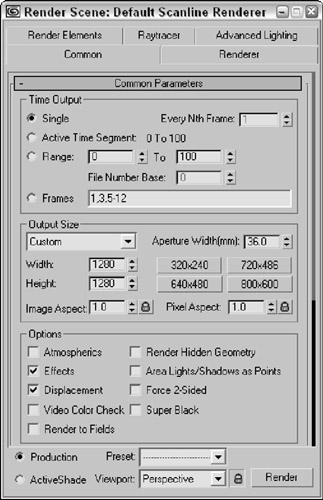
Figure 43-2: You use the Render Scene dialog box to render the final output.
| CROSS-REF | The Common and Renderer panels for the Default Scanline Renderer are covered in this chapter. The Raytracer and Renderer panel for the mental ray renderer are covered in Chapter 45, "Raytracing and mental ray," the Render Elements panel is covered in Chapter 47, "Compositing and Render Elements," and the Advanced Lighting panel is covered in Chapter 28, "Working with Advanced Lighting, Light Tracing, and Radiosity." |
Initiating a render job
At the bottom of the Render Scene dialog box are several controls that are visible for all panels; these controls let you initiate a render job. The render modes are Production and ActiveShade. Each of these modes can use a different renderer with different render settings as defined using the Assign Renderer rollout.
| Note | If any objects in the rendered scene are missing mapping coordinates, then a dialog box appears as you try to the render the scene with options to Continue or Cancel. A similar dialog box appears for any missing external files or any missing XRefs with options to continue, cancel, or browse from the missing file. |
The Preset option lets you save and load a saved preset of renderer settings. When saving or loading a preset, the Select Preset Categories dialog box, shown in Figure 43.3, opens (after you select a preset file in a file dialog box). In this dialog box, you can select which panels of settings to include in the preset. The panels listed will depend on the selected renderer. All presets are saved with the .RPS file extension.
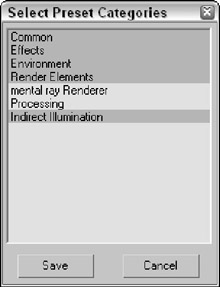
Figure 43-3: The Select Preset Categories dialog box lets you choose which settings to include in the preset.
The Viewport drop-down list includes all the available viewports. When the Render Scene dialog box opens, the currently active viewport appears in the Viewport drop-down list. The one selected is the one that gets rendered when you click the Render button. The Render button starts the rendering process. You can click the Render button without changing any settings, and the default parameters are used.
| Tip | The little lock icon next to the Viewport indicates that the selected viewport is always rendered when the Render button is clicked, regardless of the active viewport |
When you click the Render button, the Rendering dialog box appears. This dialog box, shown in Figure 43.4, displays all the settings for the current render job and tracks its progress. The Rendering dialog box also includes Pause and Cancel buttons for halting the rendering process. If the rendering is stopped, the Rendering dialog box disappears, but the Rendered Frame Window stays open.
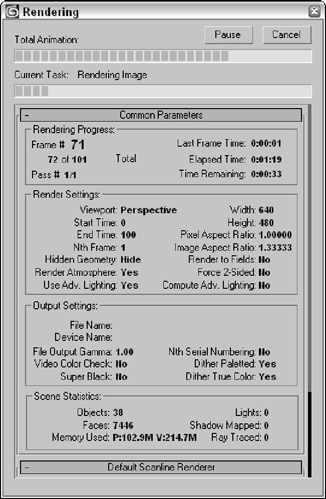
Figure 43-4: The Rendering dialog box displays the current render settings and progress of the render job.
| Caution | If you close the Rendered Frame Window, the render job still continues. To cancel the rendering, click the Pause or Cancel button, or press the Esc key on your keyboard. |
| Tip | After you've set up the render settings for an image, you can re-render an image without opening the Render Scene dialog box by clicking the Quick Render button on the main toolbar, by using the Shift+Q keyboard shortcut or by selecting a render option from the Render Shortcuts toolbar. The F9 shortcut renders the last viewport again. |
Common parameters
The Common Parameters rollout in the Render Scene dialog box includes the same controls regardless of the renderer being used.
Specifying range and size
The Time Output section defines which animation frames to include in the output. The Single option renders the current frame specified by the Time Slider. The Active Time Segment option renders the complete range of frames. The Range option lets you set a unique range of frames to render by entering the beginning and ending frame numbers. The last option is Frames, where you can enter individual frames and ranges using commas and hyphens. For example, entering "1, 6, 8–12" renders frames 1, 6, and 8 through 12. The Every Nth Frame value is active for the Active Time Segment and Range options. It renders every nth frame in the active segment. For example, entering 3 would cause every third frame to be rendered. This option is useful for sped-up animations. The File Number Base is the number to add to or subtract from the current frame number for the reference numbers attached to the end of each image file. For example, a File Number Base value of 10 for a Range value of 1-10 would label the files as image0011, image0012, and so on.
| Tip | Don't render long animation sequences using the .AVI, .MPEG, or .MOV formats. If the rendering has trouble, the entire file will be corrupt Instead, choose to render the frames as individual images. These individual images can then be reassembled into a video format using the Video Post interface or an external package like Adobe's Premiere. |
The Output Size section defines the resolution of the rendered images or animation. The drop-down list includes a list of standard film and video resolutions, including various 35mm and 70mm options, Anamorphic, Panavision, IMAX, VistaVision, NTSC, PAL, and HDTV standards. A Custom option allows you to select your own resolution.
Aperture Width is a property of cameras that defines the relationship between the lens and the field of view. The resolutions listed in the Aperture Width drop-down list alter this value without changing the view by modifying the Lens value in the scene.
For each resolution, you can change the Width and Height values. Each resolution also has six preset buttons for setting these values.
| Tip | You can set the resolutions of any of the preset buttons by right-clicking the button that you want to change. The Configure Preset dialog box opens, where you can set the button's Width, Height, and Pixel Aspect values. |
The Image Aspect is the ratio of the image width to its height. You can also set the Pixel Aspect ratio to correct rendering on different devices. Both of these values have lock icons to their left that lock the aspect ratio for the set resolution. Locking the aspect ratio automatically changes the Width dimension whenever the Height value is changed and vice versa. The Aperture Width, Image Aspect, and Pixel Aspect values can be set only when Custom is selected in the drop-down list.
Render options
The Options section includes the following options:
-
Atmospherics: Renders any atmospheric effects that are set up in the Environment dialog box.
-
Effects: Enables any Render Effects that have been set up.
-
Displacement: Enables any surface displacement caused by an applied displacement map.
-
Video Color Check: Enables a check for nonsafe NTSC or PAL colors. Nonsafe colors are displayed incorrectly when these formats are used.
-
Render to Fields: Enables animations to be rendered as fields. Fields are used by video formats. Video animations include one field with every odd scan line and one field with every even scan line. These fields are composited when displayed.
-
Render Hidden Geometry: Renders all objects in the scene, including hidden objects. Using this option, you can hide objects for quick viewport updates and include them in the final rendering.
-
Area Lights/Shadows as Points: Rendering area lights and shadows can be time consuming, but point lights render much more quickly. By enabling this option, you can speed the rendering process.
-
Force 2-Sided: Renders both sides of every face. This option essentially doubles the render time and should be used only if singular faces or the inside of an object are visible.
-
Super Black: Enables Super Black, which is used for video compositing. Rendered images with black backgrounds have trouble in some video formats. The Super Black option prevents these problems.
The Advanced Lighting panel offers options to use Advanced Lighting or Computer Advanced Lighting when Required. Advanced lighting can take a long time to compute, so these two options give you the ability to turn advanced lighting on or off.
| CROSS-REF | Advanced lighting is covered in more detail in Chapter 28, "Working with Advanced Lighting, Light Tracing, and Radiosity." |
Bitmap Proxies
The Bitmap Proxies section includes a Setup button to enable a feature that can downscale all maps for the current scene. Clicking the Setup button opens the Global Settings and Defaults for Bitmap Proxies dialog box, shown in Figure 43.5.
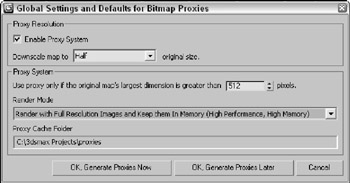
Figure 43-5: The Bitmap Proxies dialog box lets you replace all texture maps with proxy images.
| NEW FEATURE | The Bitmap Proxies feature is new to 3ds Max 9. |
The Downscale Map option lets you select to downscale all maps to Half, Third, Quarter, or Eighth, or to their current size. This lets you create your scene with high-quality maps and quickly reduce their sizes as needed without having to open and scale each individual map. The Proxy System lets you select to use a proxy image if the current map is larger than a specified size in pixels.
This dialog box also lets you set the Render Mode to be optimized for performance or memory. The options include Render with Proxies, Render with Full Resolution and Keep them [image maps] In Memory, and Render with Full Resolution and Free up the Memory once Rendered.
Choosing a Render Output option
The Render Output section enables you to output the image or animations to a file, a device, or the Rendered Frame Window. To save the output to a file, click the Files button and select a location in the Render Output File dialog box. Supported formats include .AVI, .BMP, .DDS, Postscript (.EPS), JPEG, Kodak Cineon (.CIN), Open EXR, Radiance Image File (.HDRI), QuickTime (.MOV), .PNG, .RLA, .RPF, SGI's Format (.RGB), Targa (.TGA), and .TIF. The Device button can output to a device such as a video recorder. If the Rendered Frame Window option is selected, then both the Files and Devices buttons are disabled. (The Rendered Frame Window is discussed later in this chapter.)
You also have an option to Put Image File List in Output Path, which creates a list of image files in the same location as the rendered file. You also have the choice of choosing Max's IFL standard or the Autodesk ME Image Sequence File (IMSQ). The Create Now button creates an image list instantly.
| CROSS-REF | More on using Image File Lists is covered in Chapter 29, "Understanding Animation and Keyframe Basics." |
The Net Render option enables network rendering. The Skip Existing Images option doesn't replace any images with the same filename, a feature that you can use to continue a rendering job that has been canceled.
| CROSS-REF | For more information on network rendering, see Chapter 46, "Batch and Network Rendering." |
E-mail notifications
The process of rendering an animation (or even a single frame) can be brief or it can take several days, depending on the complexity of the scene. For complex scenes that will take a while to render, you can configure Max to send you an e-mail message when your rendering is complete or if it fails. These options are in the Email Notifications rollout, shown in Figure 43.6.
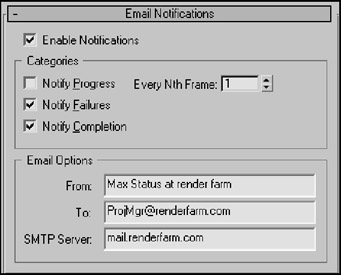
Figure 43-6: The Email Notifications rollout includes options for sending an E-mail message to report on rendering status.
In addition to the options, you can enter whom the e-mail is from, whom it is to, and an SMTP Server.
Adding pre-render and post-render scripts
The Scripts rollout includes File buttons for adding pre-render and post-render scripts. The scripts must be .ms scripts and are executed before and after the rendering of each file. These scripts can be used to compile information about the render or to do some post-processing work. Above each script file button is an Execute Now button that can be used to check the script before rendering.
Assigning renderers
Max performs rendering operations in several different places: The Render Scene dialog box renders to the Render Frame Window or to files; the sample slots in the Material Editor also are rendered; and the ActiveShade windows show another level of rendering.
The plug-in nature of Max enables you to select the renderer to use to output images. To change the default renderer, look in the Assign Renderers rollout in the Common panel of the Render Scene dialog box (F10). You can select different renderers for the Production, Material Editor, and ActiveShade modes. For each, you can select from the Default Scanline Renderer, the mental ray Renderer, and the VUE File Renderer.
| CROSS-REF | The VUE File Renderer is covered later in this chapter, and the mental ray rendering engine is covered in Chapter 45, "Raytracing and mental ray." |
The lock next to the Material Editor option indicates that the same renderer is used for both Production and Material Editor.
Scanline A-Buffer renderer
The Default Scanline Renderer rollout, found in the Renderer panel and shown in Figure 43.7, is the default renderer rollout that appears in the Render Scene dialog box. If a different renderer is loaded, then a different rollout for that renderer is displayed in the Renderer panel.
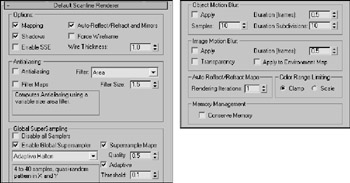
Figure 43-7: The Default Scanline Renderer rollout includes settings unique to this renderer.
You can use the Options section at the top of the Default Scanline Renderer rollout to quickly disable various render options for quicker results. These options include Mapping, Shadows, Auto Reflect/Refract and Mirrors, and Force Wireframe. For the Force Wireframe option, you can define a Wire Thickness value in pixels. The Enabled SSE option uses Streaming SIMD (Single Instruction, Multiple Data) Extensions to speed up the rendering process by processing more data per instruction.
| Tip | Intel Pentium III and later processors include the SSE instructions and can benefit from enabling this option. |
Anti-alias filters
Another way to speed up rendering is to disable the Anti-aliasing and Filter Maps features. Anti-aliasing smoothes jagged edges that appear where colors change. The Filter Maps option allows you to disable the computationally expensive process of filtering material maps. The Filter drop-down list lets you select image filters that are applied at the pixel level during rendering. Below the drop-down list is a description of the current filter. The Filter Size value applies only to the Soften filter. Available filters include the following:
-
Area: Does an anti-aliasing sweep using the designated area specified by the Filter Size value.
-
Blackman: Sharpens the image within a 25-pixel area; provides no edge enhancement.
-
Blend: Somewhere between a sharp and a coarse Soften filter; includes Filter Size and Blend values.
-
Catmull-Rom: Sharpens with a 25-pixel filter and includes edge enhancement.
-
Cook Variable: Can produce sharp results for small Filter Size values and blurred images for larger values.
-
Cubic: Based on cubic-spline curves; produces a blurring effect.
-
Mitchell-Netravali: Includes Blur and Ringing parameters.
-
Plate Match/MAX R2: Matches mapped objects against background plates as used in Max R2.
-
Quadratic: Based on a quadratic spline; produces blurring within a 9-pixel area.
-
Sharp Quadratic: Produces sharp effects from a 9-pixel area.
-
Soften: Causes mild blurring and includes a Filter Size value.
-
Video: Blurs the image using a 25-pixel filter optimized for NTSC and PAL video.
SuperSampling
Global SuperSampling is an additional anti-aliasing process that you can apply to materials. This process can improve image quality, but it can take a long time to render; you can disable it using the Disable all Samplers option. Supersampling can be enabled in the Material Editor for specific materials, but the SuperSampling rollout in the Material Editor also includes an option to Use Global Settings. The Global Settings are defined in the Default Scanline Renderer rollout.
Max includes anti-aliasing filters as part of the rendering process. You have several SuperSampling methods from which to choose.
SuperSampling can be enabled even if the Antialiasing option is disabled. Global Supersampling can be enabled using the Enable Global Supersampler option.
In a SuperSampling pass, the colors at different points around the center of a pixel are sampled. These samples are then used to compute the final color of each pixel. Max has four available SuperSampling methods: Max 2.5 Star, Hammersley, Adaptive Halton, and Adaptive Uniform.
| CROSS-REF | You can find more information on each of these sampling methods in Chapter 21, "Creating and Applying Simple Materials." |
Motion Blur
The Default Scanline Renderer rollout also offers two different types of motion blur: Object Motion Blur and Image Motion Blur. You can enable either of these using the Apply options.
Object Motion Blur is set in the Properties dialog box for each object. The renderer completes this blur by rendering the object over several frames. The movement of the camera doesn't affect this type of blur. The Duration value determines how long the object is blurred between frames. The Samples value specifies how many Duration units are sampled. The Duration Subdivision value is the number of copies rendered within each Duration segment. All these values can have a maximum setting of 16. The smoothest blurs occur when the Duration and Samples values are equal.
Image Motion Blur is also set in the Properties dialog box for each object. This type of blur is affected by the movement of the camera and is applied after the image has been rendered. You achieve this blur by smearing the image in proportion to the movement of the various objects. The Duration value determines the time length of the blur between frames. The Apply to Environment Map option lets you apply the blurring effect to the background as well as the objects. The Work with Transparency option blurs transparent objects without affecting their transparent regions. Using this option adds time to the rendering process.
| CROSS-REF | You can add two additional blur effects to a scene: the Blur Render Effect, found in the Rendering Effects dialog box (covered in Chapter 44, "Using Atmospheric and Render Effects") and the Scene Motion Blur effect, available through the Video Post dialog box (covered in Chapter 48, "Using the Video Post Interface"). |
Other options
The Auto Reflect/Refract Maps section lets you specify a Rendering Iterations value for reflection maps within the scene. The higher the value, the more objects are included in the reflection computations, and the longer the rendering time.
Color Range Limiting offers two methods for correcting over-brightness caused by applying filters. The Clamp method lowers any value above a relative ceiling of 1 to 1 and raises any values below 0 to 0. The Scale method scales all colors between the maximum and minimum values.
The Conserve Memory option optimizes the rendering process to use the least amount of memory possible. If you plan on using Max (or some other program) while it is rendering, you should enable this option.